Samsung Galaxy S 5 Review
by Anand Lal Shimpi & Joshua Ho on April 8, 2014 12:00 AM EST- Posted in
- Smartphones
- Samsung
- Mobile
- Galaxy S 5
Display
As the smartphone market continues to mature, the distinguishing between smartphones becomes harder and harder as OEMs continue to converge in platform and in most other aspects. This is most evident when looking at the progression from the Galaxy S2 generation to today. Back then, the Galaxy S2 was notable because of its Exynos 4210 SoC, which was far ahead of Qualcomm’s dual core Scorpion solutions at the time, which meant non-Samsung OEMs had notably worse CPU and GPU performance. The same was also true for the original Galaxy S with its Hummingbird SoC. Today, just about every OEM ships the same SoC. The difference between 8974AB and 8974AC is effectively only an eight percent CPU bump for the AC variant.
One of the key differentiators now in the market is display. The Galaxy S 5 features a 5.1-inch 1080p Full HD Super AMOLED display, equipped with the usual set of software defined color profiles. The GS5 gets a new adaptive profile that automatically adjusts the tint of the display according to the color of the ambient light. It's a neat effect, however Samsung's Cinema mode still ends up being the most accurate.
As always, we measure color accuracy using Spectracal’s CalMAN 5 software and a custom workflow for smartphones and tablets.
The results show that the Galaxy S5 has a display that is dramatically improved from the Galaxy S4. However, the Galaxy S line doesn’t exist in a vacuum, so it’s important to also look at how it compares against the best LCDs in other phones. In this department, things aren’t quite as perfect. To start, the color gamut control is still rather poor even on Cinema mode, as effectively all of the secondary colors miss the sRGB targets for saturation sweep. Yellow, cyan secondaries and green primaries are also notably out of the sRGB gamut triangle. While recent headlines have raved about the Galaxy S5’s record-setting color accuracy, I don’t see this at all in the results. Still, against the competition in the Android space, Samsung has improved a tremendous amount while other OEMs seem to be stagnating or even regressing in color accuracy. The only Android OEM that actually beats Samsung in the color accuracy department is now Google, which is strange because they contract out their hardware to other Android OEMs.
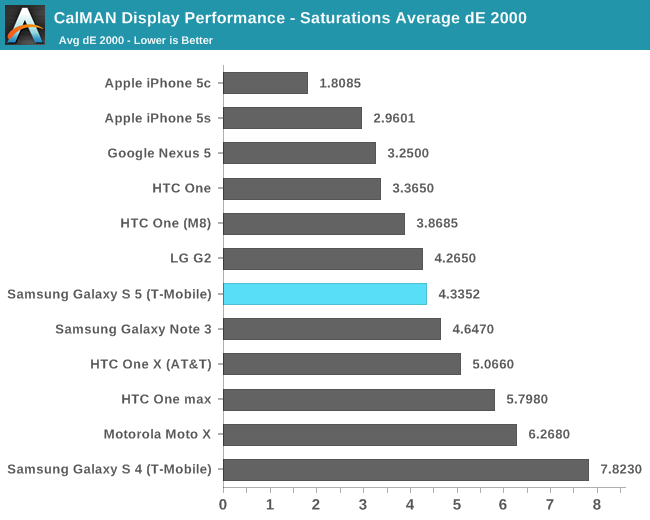
Looking at the saturation sweep, it’s evident that Samsung is now about equivalent to LG in color accuracy for their displays. HTC is barely ahead, with such a small difference that it’s not worth counting. Only Google and Apple have a noticeable lead in this department, a huge improvement from 2013 when Samsung trailed far behind most other competitors in this test.
In the Gretag Macbeth Colorchecker, Samsung continues to hold its position, beating all but Google and Apple. HTC is noticeably behind in this department compared to Samsung, as the One (M8) is horrific in this department compared to even the original HTC One.
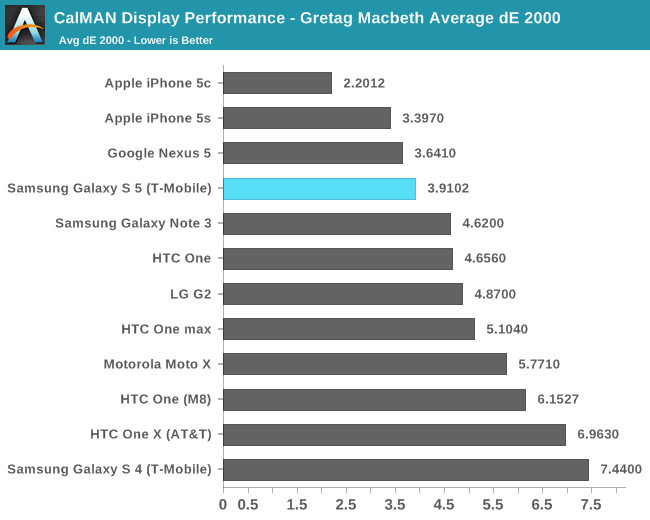
In the contrast department, Samsung continues to dominate, with effectively infinite contrast. Based upon some quick viewing of the display in the darkest room I have in the house, I don’t see any obvious DC bias issues. Unfortunately, I still see some ghosting on the display at low brightness which manifests as a purple trail when scrolling. This seems to be unchanged from the Galaxy S4. The minimum white brightness is around 1.8 nits, which is great for reading at night, as many LCD-screened phones such as the LG G Pro 2 have a minimum white brightness of around 7-12 nits.
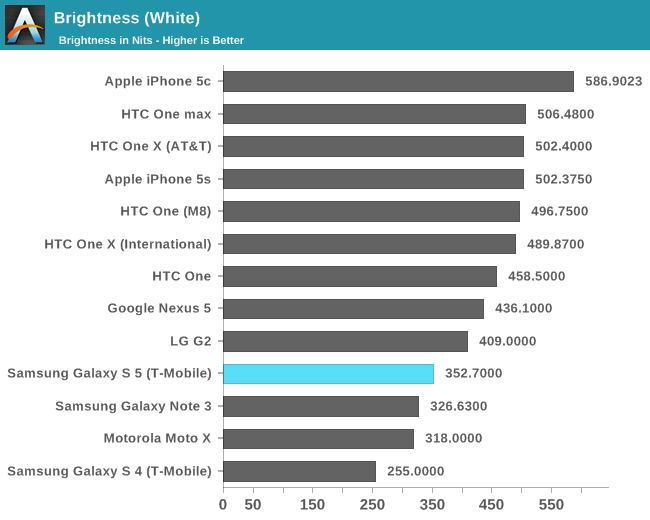
Samsung has also made great gains in the maximum brightness department, which is especially pleasing because for the longest time, AMOLED was noticeably less bright which made it incredibly difficult to read webpages and similar content outdoors. I’m happy to say that this is no longer the case, as the Galaxy S5 now has a display that realistically reaches around 440 nits outdoors with a pure white image, although this requires auto-brightness to be on and will vary with the screen mode. The maximum that is accessible without this daytime boost mode is somewhere around 350 nits.
The problem is the way Samsung has achieved this, something that is shown in the grayscale tests. While Samsung has done a great job in clamping down the white point to around 6504k, grayscale is so noticeably green that not only does CalMAN show this in the measurements, but also casual observation. I can literally see that the grayscale image is not gray, but an off-green. I’m not quite sure how this happened, but I suspect that this was done in an effort to increase peak brightness as even in the bluest display mode, green is still closely tracking with blue.
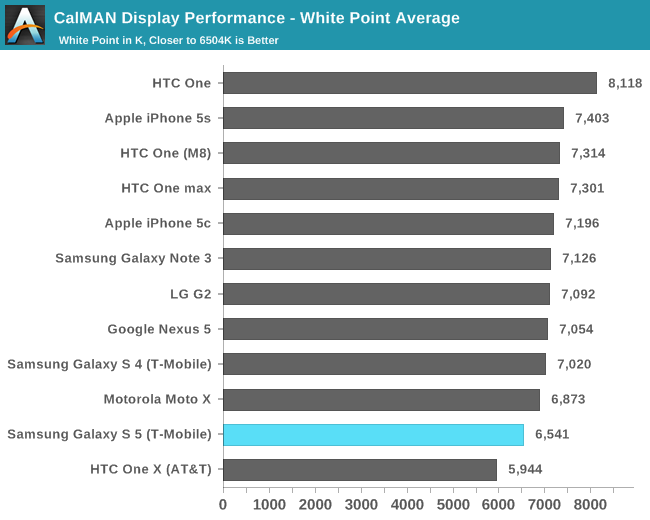
Overall, I’m quite pleased with the display. The AMOLED display in the Galaxy S5 is finally equivalent to LCD displays in color accuracy and peak luminance, areas that LCD used to be the best in. Throw in the incredible contrast that AMOLED has always had and the ability to toggle between wide color gamut and accurate color, and I would say that AMOLED is finally equal, if not slightly better than LCD. With a few more iterations, I wouldn’t be surprised if I were to write that AMOLED is clearly superior to LCD. Of course, there are some issues such as a noticeable green tint to the display in grayscale and Samsung still needs to improve their clamping of gamut to sRGB for Cinema/Movie mode, but none of these issues seriously detract from the viewing experience.


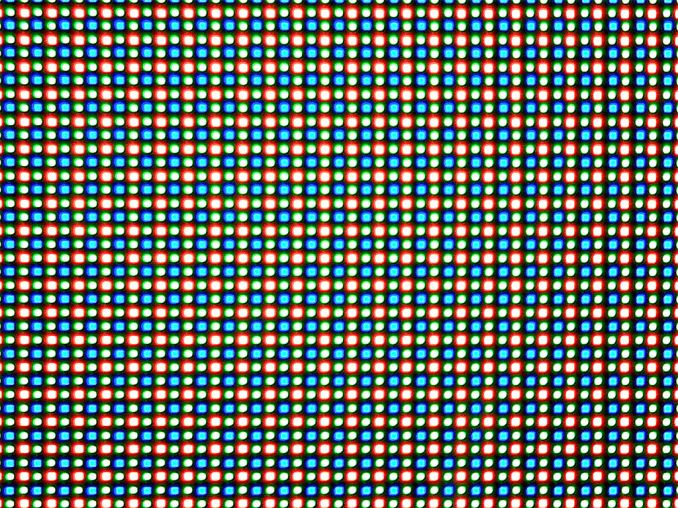












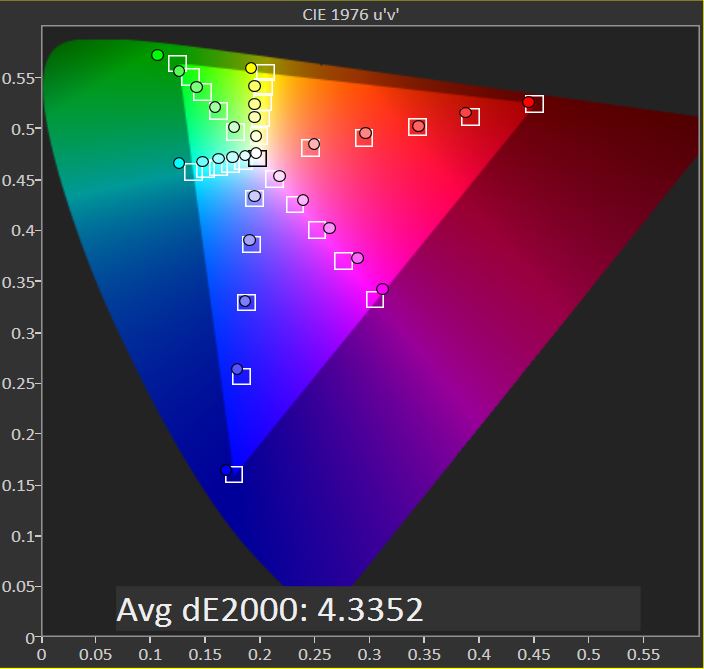
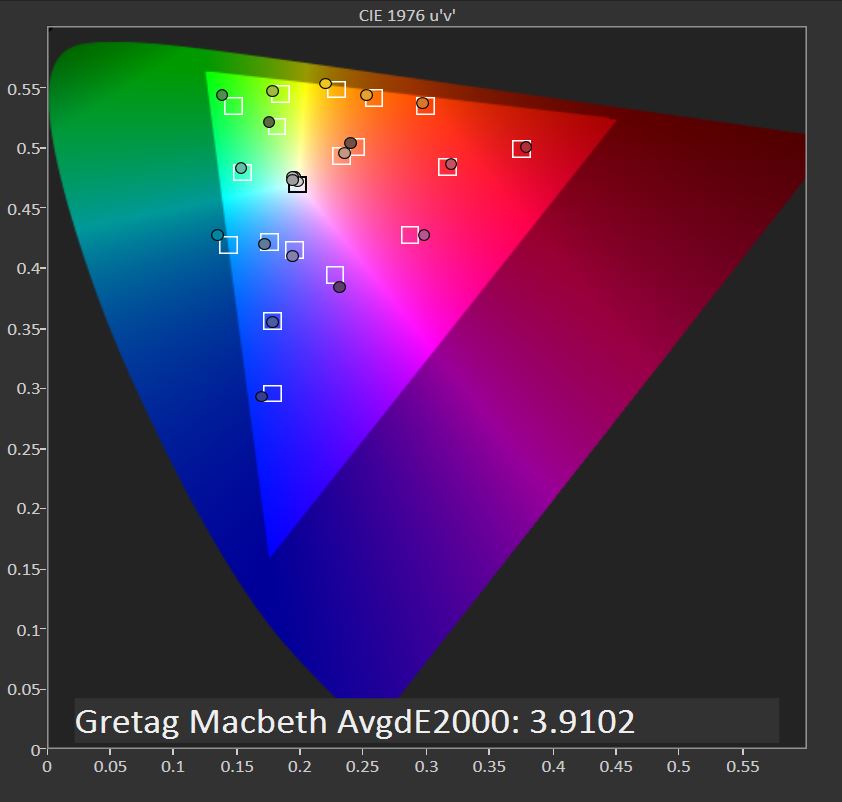









296 Comments
View All Comments
Saltank - Wednesday, April 9, 2014 - link
Not a single word about actually making phone calls? No call quality / HD Voice stuff? I was awestruck by how awesome my iPhone 5 handles regular non-HDVoice calls, and the GS3 was good, too, but my old HTC One was subpar.Also, how come camera comparisons don't take WP's in to account? No Lumia 1020/1520/930?
Lightstorm66 - Wednesday, April 9, 2014 - link
I thought Anandt ech knew that the Samsung Browser is faster than chrome and achieves in the Galaxy S5 even better results than the iphone 5s in sunspider.Galaxy S5: 385,8 ms
iphone 5s: 414,7 ms
ryanmt - Wednesday, April 9, 2014 - link
The LG G2 is the unsung camera hero here. It outperforms it all. Why are only the HTC M8 and 5S called out for their good low light performance when the G2 is actually (subjectively) better?echo9251 - Wednesday, April 9, 2014 - link
There should be more talk about the lack of a 64MB option. I have a 64MB HTC One (M7) and enjoy never having to worry about running out of storage for apps, etc. Losing half my storage is a big disincentive to "upgrading" to a new phone.Brian Z - Wednesday, April 9, 2014 - link
Well they did include a micro SD card that supports up to 128gb.I am not going to make the case that having more storage considering the outrageous prices of the these devices. But at a point it gets a ridiculous. People complain loud OMG no external storage. No buy. Then they make 32gb device with expandable storage. People still complain
Streamlined - Thursday, April 17, 2014 - link
Uh, because SD cards are dog slow compared to storage on the motherboard. SD CARDS SUCK and that is why HTC includes larger storage options. Just another reason the M8 is the best Android phone money can buy.Myrandex - Wednesday, April 9, 2014 - link
I'm disappointed no Nokia's showed up in the camera tests. I've love to see how this lined up with my Lumia 920, particularly in the low light tests. My wife's 1020 is a beast too.Souka - Wednesday, April 9, 2014 - link
Here's a another way to test durability and take apart a S5https://www.youtube.com/watch?v=newNF1UsOcw
dlang1234 - Wednesday, April 9, 2014 - link
What I'm most impressed by, is how well the LG G2 is performing at these benchmarks against much newer phones. I have had my G2 for a while now, and it is an awesome phone.. so much so that these phones look more like side grades than upgrades even though, I mean it was released September 12, 2013 and now almost 6 months later, the epic increases of speed in mobile seems to be subsiding some.chrcoluk - Wednesday, April 9, 2014 - link
agreed.I own a S3 and a galaxy ace.
The galaxy ace has cyanogen mod 7.2 installed on it.
The S3 has touchwiz based on android 4.3
In terms of hardware spec the S3 is many multiples more powerful than the ace.
However many basic functions are much snappier on the ace, in particurly using it as a phone, bringing up the call log, scrolling the call log, making calls, answering calls, opening contacts, all these functions much faster on the ace. The ace also wakes up immediatly whilst the S3 has wake lag, the ace has much longer lasting battery even tho it has a weaker battery. However the ace does suck when it comes to using it for the internet/gaming most 3rd party apps as thats where its hw spec hits it, but its limitations are mostly down to its lack of ram. IT seems to always have more spare cpu cycles than the S£ as the S3 is bogged down by touchwiz.
So why havent I got the S3 on AOSP. google edition etc? the problem is the contacts/dialer app on AOSP sucks really bad, its aweful. Especially with the default white background. Samsung have at least maintained a half decent UI design in their dialer/contacts the problem is its mega laggy. But sadly UI design wins over performance. CM7.2 has the best ever dialer/contacts I have seen on a android phone but new phones cannot use CM7.2.
I have recently decided to start using the ace as my main phone (its easier to use out and about also due to its smaller size) and primarily use the S3 as a portable computing device. That way I can stick AOSP on the S3 and not worry about the crappy contacts app.
Do samsung deliberatly make their interface laggy? not sure, its certianly possible tho as they want to give a people a reason to upgrade to the next phone every year.
Also notice how every new software update increases the fotn size as well, to give people a reason to want the higher DPI. The relative font size looks equal on my ace vs the S3 even tho the S3 has a way higher resolution.